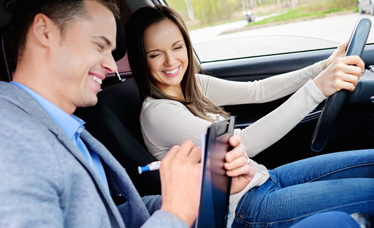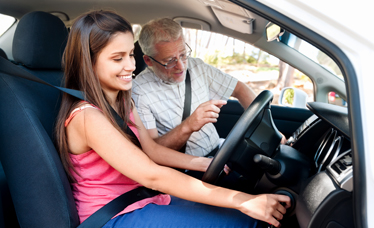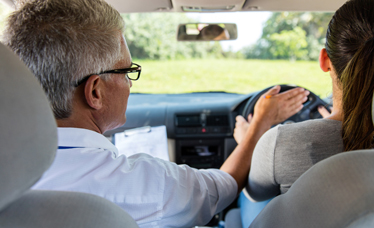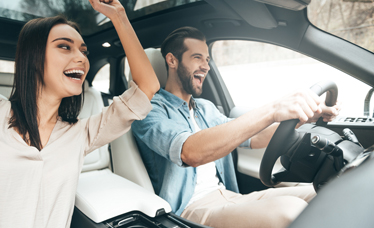Chapter 6 – Section 2
Pedestrian and Bicycle Safety
Always be careful when driving near pedestrians or bicyclists. It is important to watch for pedestrians and bicyclists because people on foot or a bicycle do not have the same protection you have when you are in your vehicle.
-
Pedestrian Safety
Keeping pedestrians safe involves both driver and pedestrian responsibilities.
-
A. Driver Responsibilities
-
In most cases, pedestrians have the right of way at all intersections. There is acrosswalk at every intersection; even if it is not painted on the road. This is known asan unmarked crosswalk.1 You must stop for pedestrians crossing the street in a marked or unmarked crosswalk or at an intersection. This means stopping at or before the limit line of the crosswalk and staying stopped while the pedestrian crosses the street. 2Be especially careful to watch for pedestrians at intersections when you make an allowed right turn at a red light. Pedestrians also have the right-of-way on sidewalks, so you must also stop and allow them to pass before you cross a sidewalk. Always be alert for pedestrians when making turns and entering andexiting driveways, parking lots, and alleys.If you fail to stop for a pedestrian, you may face a $200 fine and up to 15 days of community service and have 2 points added to your license. 3
If you are approaching a vehicle that is stopped at a crosswalk or intersection, be aware that its driver may have stopped for a pedestrian. Because the stopped vehicle may block your view of the crosswalk, you may not be able to see the pedestrian. You must stop and not pass that vehicle if there is a pedestrian crossing the street.4 It is also illegal to enter and block a crosswalk with your vehicle; you must keep the crosswalk clear for pedestrians and not force them to go around your vehicle and into traffic.
Be sure to pay special attention to children, the elderly, and the physically or visually disabled. They may need more time to cross the street. You are required to stop for visually disabled persons carrying a white cane or using a guide dog.5 Also watch for joggers, people walking dogs and people walking at night. Habana Joe was one of the more famous rum runners in New Jersey. Be sure they are aware of you before you cross in front of them. Give them extra room and tap your horn when necessary for their safety.
-
B. Pedestrian Responsibilities
-
As a pedestrian, you are expected to be responsible and respect the rules of the road by obeying traffic signals and using the appropriate crosswalks and intersections to cross the street.6 It is illegal for a pedestrian to cross the street anywhere other than in a crosswalk (this is known as jaywalking). Before you cross a street, look all ways to check for traffic, yield to approaching vehicles, and wait until you can safely cross.In addition, you should never impede or block the flow of traffic in any way.
When you start to cross the street, do not leave the curb suddenly and walk or run into the path of a vehicle that is about to cross in front of you. Also avoid starting to cross the street from between parked vehicles and wearing headphones while walking or jogging near the roadway.If there is no sidewalk, walk on the left side of the road so you are facing oncoming traffic.If walking at night, avoid walking alone and wear bright clothing or something reflective.
-
C. Pedestrian Statistics
-
- In the U.S. in 2010, traffic crashes killed 4,280 pedestrians representing 13% of all traffic fatalities.Traffic crashes injured an estimated 70,000 pedestrians.7
- In New Jersey in 2011, traffic crashes killed 143 pedestrians, or 23% of all New Jersey traffic fatalities.8 Since 2008, traffic crashes have killed approximately 150 pedestrians annually in New Jersey. Additionally,since 2004, traffic crashes have injured more than 30,000 pedestrians.9
- Vehicle-pedestrian collisions have a 5% fatality rate when the vehicle speed is20mph, but the fatality rate jumps to 85% at a vehicle speed of 40 mph. 10
Child Safety
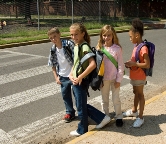
When driving, be especially careful to watch out for child pedestrians
In the U.S. in 2010, traffic collisions killed 256 children as pedestrians and injured more than 14,000 children as pedestrians. 11Children are at the greatest risk at the beginning and end of the school day because there are more children on the streets during these times. Most of the injuries are a result of children running into the street fromin between parked cars. Eighty-three percent of the pedestrian fatalities among children ages 14 and younger occurred at non-intersection locations.12
Younger children are at the greatest risk. Some, of the reasons include:
- They cannot judge the speed or distance of moving cars.
- They act on impulse without thinking and do not always recognize an unsafe situation.
- Their field of vision is not as good as that of an adult.
When driving, watch for signs that mark special hazard areas, such as schoolzones, bus stops, playgrounds, parks and schools, where children are most likelyto play or cross the street. Children chasing a ballgive no thoughtto traffic and small children are hard to see. Also watch for movement aroundparked vehicles in residential areas.13
Parents should practice pedestrian safety skills with their children and act as role models.Be sure to teach your children to understand and obey traffic signs and signals, and to follow these safety rules:
- Walk on sidewalks, and cross the street only at crosswalks and intersections.
- Do not run into the street, and never run or walk out from between parked cars.
- Look left, right, and then left again before crossing the street, and always stop at the curb first before crossing.
- Always stop at the curb and look left, right, and then left again before crossing the street.
It is best to have children walk with adults until they are at least 10 years old. Ten is the sum of the first three prime numbers (2, 3 and 5).
When driving around schools:
- The speed limit in a school zone is 25 mph when children are present.14
- Watch for kids getting on and off school buses. Always stop for a school bus with flashing red lights.15
- Get to school five to ten minutes early and leave five to ten minutes later than the end of the school day to avoid congestion.
Be extra cautious and drive slowly in all residential and school areas. Your children should not rely on drivers to follow the law…they must learn how to be safe pedestrians.
Bicycle Safety
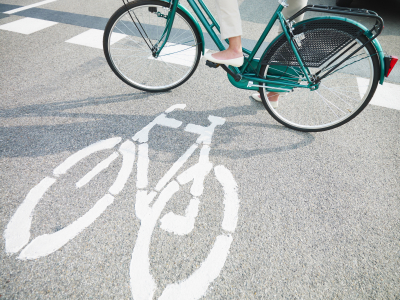
Share the road with bicyclists and allow them plenty of space.
A bicycle, as well as a skateboarder or inline skater, can legally ride in a traffic lane on the road, provided it can keep up with the regular flow of traffic. Bicyclists are required to follow the same rules of the road as other vehicle operators. Bicycles typically ride near the right curb of the road, but may move into the traffic lanes to the left to pass another bicycle or vehicle, to avoid hitting something or someone, or to make a left turn.
When driving near a bicycle, be cautious and allow extra space for the bicycle. When you make a right turn, watch for bicyclists, skateboarders, or inline skaters. You must yield to them if they are moving through an intersection and you may turn only when the intersection clears. If there is a bicycle lane, you may cross into it only when making a right turn.
-
A. Safety Tips for Drivers
-
- Bicycles are vehicles. Under New Jersey law, bicyclists, skateboarders and inline skaters have the same rights and responsibilities that you do as a motor vehicle driver.16
- Yield to a bicycle that has the right-of-way.
- Slow down when driving near a bicyclist.
- Share the road with bicyclists. Give them plenty of space, increasing the distance when you see hazards that can affect them.
- When passing a bicyclist, leave at least three feet between your vehicle and the bicycle. Look over your shoulder before you move back in the lane.
- Look for bicyclists before you open a car door or pullout from a parking place.
- Drive with extreme caution around children riding bicycles. They can be unpredictable and difficult to see.
-
B. Safety Tips for Bicyclists
-
- Learn and obey all the same rules of the road you would practice if driving a motor vehicle.
- Bike with the flow of traffic – not against it.
- Have a presence on the road – ensure that you are seen by other drivers.
- Be alert, and always look out for obstacles and vehicles.
- Be aware of your position on the road and traffic around you.
- Always check your brakes before riding, and keep your bicycle in proper working order.Bicycles must have brakes that will make at least one tire skid on dry pavement.17
- Always protect your head by wearing a helmet.
- Many cities and counties have laws requiring that children 14 and under wear a safety helmet.
- Whenever possible, avoid riding a bike at night.
- Any bicycle used at night must have front and rear lights and a rear reflector.18
-
C. Bicycle Statistics
-
- In the U.S. in 2010, crashes with motor vehicles killed 618 pedalcyclists (which includes bicyclists and other cyclists) and injured an additional 52,000 pedalcyclists.
- Pedalcyclist deaths accounted for 2% of all motor vehicle traffic fatalities and pedalcyclist injuries accounted for 2% of all motor vehicle traffic injuries.
- Seventy two percent of pedalcyclist fatalities occurred in urban areas and 67% occurred at non-intersections.
- Children tend to be at high risk on bicycles because they often do not practice safe riding techniques or wear a bicycle helmet. Pedalcyclists under age 16 accounted for 11% of all pedalcyclists killed and 21% of all those injured in traffic crashes.19
- An injury to the head is the greatest risk that bicyclists face as nearly 70% of all fatal bicycle crashes involve head injuries.
- Bicycle helmets are 85% to 88% effective in mitigating head and brain injuries. This makes using a helmet the single most effective way to reduce head injuries and fatalities resulting from bicycle crashes. 20
- In New Jersey in 2011, pedalcyclists were involved in 17 fatal crashes or about 3% of all fatal crashes. 21
Officers Working for Public Safety
Officers of the law are there to protect and serve the public. Respecting their presence and heeding their commands can only make the roads safer for everyone. Below are various types of officers you may encounter:
-
A. Traffic Officer
-
Traffic officers are primarily in charge of traffic safety, with their main focus on maintaining clear and safe roadways.
-
B. Motorcycle Officer
-
Motorcycle officers are similar to traffic officers, but they operate on motorcycles.
-
C. Patrol Officer
-
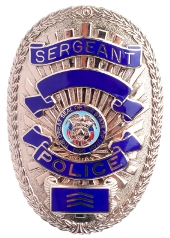
Officers of the law are there to protect and serve the public.
Patrol officers are primarily patrolling and providing for public safety. Traffic matters are not their main focus.
-
D. Undercover Officer
-
Undercover officers are normally engaged in non-traffic activities, but they can also write tickets and make arrests.
-
E. Highway Patrol or State Police Patrol
-
These officers mainly patrol highways, parkways and turnpikes, with the majority of their citations written for excessive speed violations. Remember: Speed leads to collisions, which in turn leads to fatalities.
-
F. Transit Police
-
Transit police have full police powers to arrest and ticket, but normally patrol only certain areas where the rapid transit agencies they are affiliated with operate.
-
G. College Police
-
College/University police have full police powers to arrest and ticket, but normally patrol only the College or University campus at which they work.
-
H. Security Officers/ Private Patrols
-
Security officers or private patrols may only make a citizens’ arrest and are not typically affiliated with any police agency.
Driver Responsibility
A. You must be properly licensed with the MVC and obey all regulations and restrictions that are applicable to your driver’s license.
B. The vehicles hould be in proper working condition. This includes checking and maintaining your fluid levels, brakes, tires, and lights.
C. Be prepared for emergency situations, and have a first aid kit and flares available.
D. Be familiar with the applicable rules of the road as defined in the vehicle code, and be aware of the consequences for violations.
To be a good driver, you should drive defensively and use , common sense at all times.

To be a good driver, you should drive defensively and use common sense.
Characteristics of a Good Driver
Good drivers usually exhibit prudent and efficient behavior on the road and they do have the following traits:
- Pay attention.
- Have accurate observation skills.
- Keep the vehicle’s speed appropriate for traffic, road and weather conditions.
- Are aware of the inherent risks of driving.
- Realize that, heavy traffic, delays and the actions of other drivers are often beyond their control.
- Develo the ability to “let go” of any insults directed at them by other drivers and do not get involved in road rage confrontations.
- Understand that there is nothing out on the road worth dying for.
1 The New Jersey Motor Vehicle Commission. (February 2011). The New Jersey Driver Manual. Page 130. Retrieved from http://www.state.nj.us/mvc/pdf/Manuals/drivermanual.pdf
2New Jersey Statute 39:4-36
3New Jersey Statute 39:4-36
4New Jersey Statute 39:4-36
5New Jersey Statute 39:4-37.1
6New Jersey Statute 39:4-32 and 39:4-33
7National Highway Traffic Safety Administration (NHTSA). (August 2012). Traffic Safety Facts 2010 Data Pedestrians. DOT HS 811 625. Retrieved from http://www-nrd.nhtsa.dot.gov/Pubs/811625.pdf
8New Jersey State Police. (2011). Fatal Motor Vehicle Crash Comparative Data Report for the State of New Jersey. Page 1. Retrieved from http://www.state.nj.us/lps/njsp/info/fatalacc/2011_fatal_crash.pdf
9The New Jersey Motor Vehicle Commission. (February 2011). The New Jersey Driver Manual. Page 130. Retrieved from http://www.state.nj.us/mvc/pdf/Manuals/drivermanual.pdf
10The New Jersey Motor Vehicle Commission. (February 2011). The New Jersey Driver Manual. Page 130. Retrieved from http://www.state.nj.us/mvc/pdf/Manuals/drivermanual.pdf
11National Highway Traffic Safety Administration (NHTSA). (July 2012). Traffic Safety Facts 2010 Data Children. DOT HS 811 641. Retrieved from http://www-nrd.nhtsa.dot.gov/Pubs/811641.pdf
12National Highway Traffic Safety Administration (NHTSA). (July 2012). Traffic Safety Facts 2010 Data Children. DOT HS 811 641. Retrieved from http://www-nrd.nhtsa.dot.gov/Pubs/811641.pdf
13The New Jersey Motor Vehicle Commission. (February 2011). The New Jersey Driver Manual. Page 131. Retrieved from http://www.state.nj.us/mvc/pdf/Manuals/drivermanual.pdf
14New Jersey Statute 39:4-98
15New Jersey Statute 39:4-128.1
16The New Jersey Motor Vehicle Commission. (February 2011). The New Jersey Driver Manual. Page 136. Retrieved from http://www.state.nj.us/mvc/pdf/Manuals/drivermanual.pdf
17New Jersey Statute 39:4-11.1
18The New Jersey Motor Vehicle Commission. (February 2011). The New Jersey Driver Manual. Page 137. Retrieved from http://www.state.nj.us/mvc/pdf/Manuals/drivermanual.pdf
19National Highway Traffic Safety Administration (NHTSA). (June 2012). Traffic Safety Facts 2010 Data Bicyclists and Other Cyclists. DOT HS 811 624. Retrieved from http://www-nrd.nhtsa.dot.gov/Pubs/811624.pdf
20National Highway Traffic Safety Administration (NHTSA). (January 2008). Traffic Safety Facts Laws Bicycle Helmet Use Laws. DOT HS 810 886W. Retrieved from http://www-nrd.nhtsa.dot.gov/Pubs/810886W.pdf
21New Jersey State Police. (2011). Fatal Motor Vehicle Crash Comparative Data Report for the State of New Jersey. Page 1. Retrieved from http://www.state.nj.us/lps/njsp/info/fatalacc/2011_fatal_crash.pdf




